Want more ideas and freebies?
Get my free resource library with digital & print activities—plus tips over email.
Join for Free Resources →
$4.25
Ever wondered how to teach the distributive property and combining like terms in an engaging way to your 7th-grade students? In this lesson plan, students will learn about how to simplify algebraic expressions with positive and negative coefficients. Through artistic, interactive guided notes, check for understanding, practice activities, and a maze worksheet, students will gain a comprehensive understanding of simplifying expressions. The lesson culminates with a real-life example that explores how these skills can be used in a practical context.
Note: For lesson plan with positive coefficients only, click here.

$4.25
After this lesson, students will be able to:
Before this lesson, students should be familiar with:
As a hook, ask students why learning about the distributive property and combining like terms is important in real life. For example, you can ask them how they would calculate the total cost of buying multiple items at a store. Refer to the last page of the guided notes as well as the FAQs below for more ideas.
Use the first page of the guided notes to introduce the distributive property. Walk through the key points of the distributive property, explaining that it allows us to simplify expressions by distributing a value to each term within parentheses. Emphasize the concept of multiplying each term inside the parentheses by the value outside the parentheses. Refer to the FAQ below for a walk through on this, as well as ideas on how to respond to common student questions.
Use the second page of the guided notes to introduce combining like terms (after distributing). Walk through the key points of combining like terms, explaining that it involves simplifying an expression by adding or subtracting the coefficients of like terms (terms with the same variable and exponent). Emphasize the importance of identifying like terms and performing the indicated operations.
Based on student responses, reteach the concepts of the distributive property and combining like terms that students may need extra help with. If your class has a wide range of proficiency levels, you can pull out students for reteaching, and have more advanced students begin working on the practice exercises.
Have students practice using the distributive property and combining like terms using the practice worksheets (pg. 3 of guided notes) provided in the resource. Walk around the classroom to answer any student questions and provide assistance as needed.
Fast finishers can dive into the color by number activity (pg. 4) and maze activity (pg. 5), where they can practice how to simplify expressions. These activities can also be assigned as homework for students to complete outside of class.
Use the last page of the guided notes (pg. 6) to bring the class back together, and introduce the concept of real-life applications of using distributive property and combining like terms to simplify expressions. Explain that these math skills are not just used in the classroom, but also in everyday life.
Some examples of real-life applications include:
By understanding these concepts and being able to apply them in real-life situations, students will develop critical thinking skills and see the practicality of math in their everyday lives.
Refer to the FAQ section of the resource for more ideas and examples on how to teach the real-life application of distributive property and combining like terms.
If you're looking for digital practice for distributive property and combining like terms, try my Pixel Art activities in Google Sheets. Every answer is automatically checked, and correct answers unlock parts of a mystery picture. It's incredibly fun, and a powerful tool for differentiation.
Here are 2 activities to explore:
A fun, no-prep way to practice distributive property and combining like terms is Doodle Math—they're a fresh take on color by number or color by code. It includes multiple levels of practice, perfect for a review day or sub plan.
Here are 2 activities to try:
The distributive property of multiplication states that when you multiply a number by a sum, you can multiply each addend separately and then add the products together.
To use the distributive property to simplify expressions, follow these steps:
Combining like terms is the process of adding or subtracting terms that have the same variable(s) raised to the same power(s). This simplifies expressions by combining similar terms into a single term.
To combine like terms in an expression, follow these steps:
Sure! Let's simplify the expression: 2(3x + 5) - 4(2x - 1)
Here are some strategies to reinforce the concept of the distributive property and combining like terms:
Yes! Here are some online resources and games you can use to practice the distributive property and combining like terms:
To assess your students' understanding of the distributive property and combining like terms, consider using the following methods:
Get my free resource library with digital & print activities—plus tips over email.
Join for Free Resources →